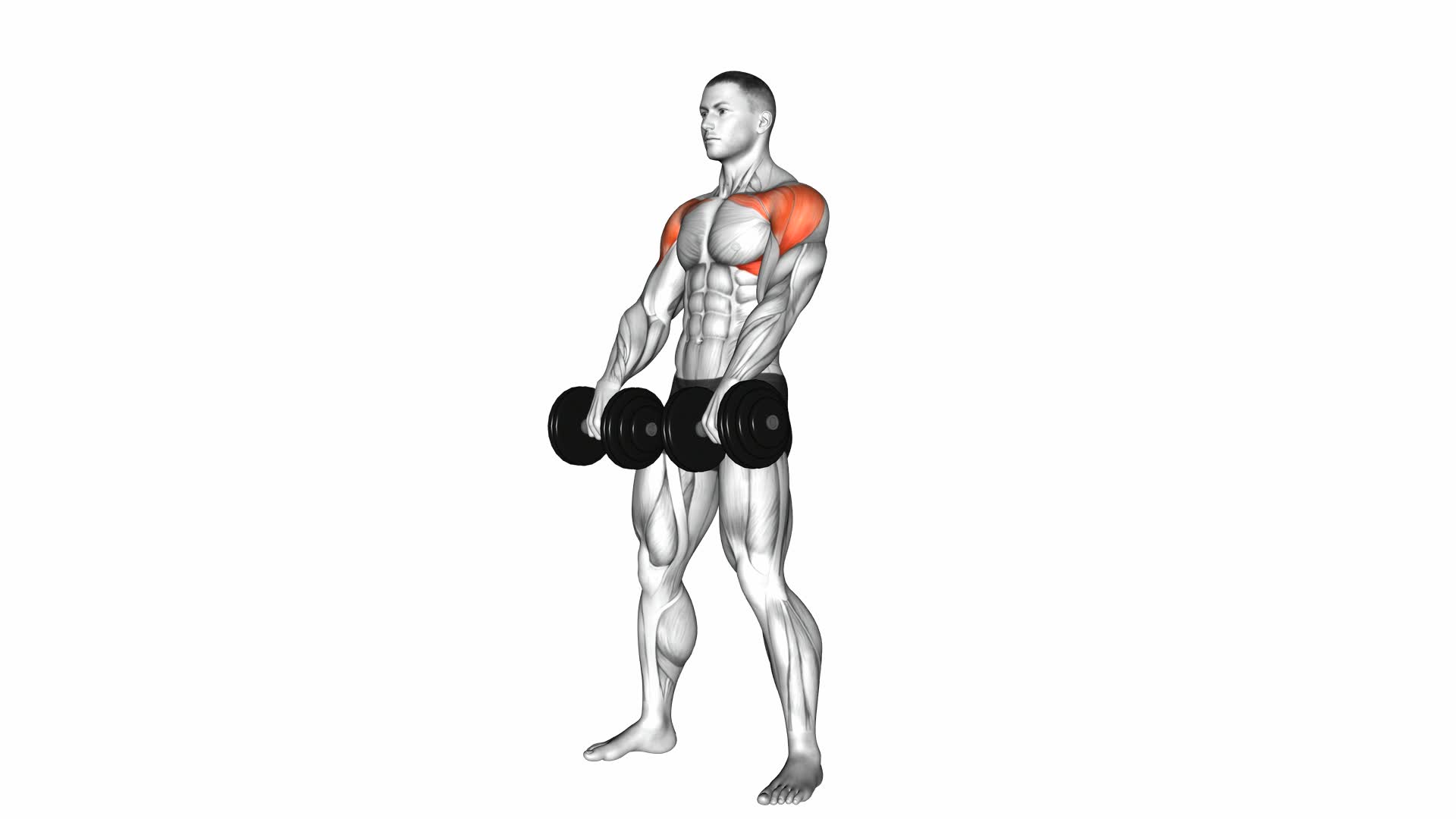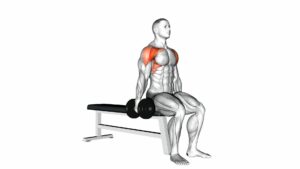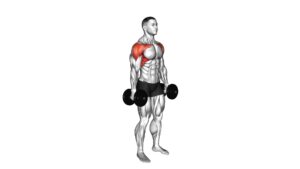Dumbbell Standing Alternate Raise – Video Exercise Guide & Tips

Looking to tone your arms and build strength? The dumbbell standing alternate raise is a great exercise for you. In this video exercise guide, we'll show you the proper form and technique to ensure maximum results.
Watch This Exercise Video
Learn how to choose the right dumbbells and follow step-by-step instructions for a successful workout. Avoid common mistakes and get expert tips for boosting your performance.
Get ready to sculpt those arms and feel the burn!
Key Takeaways
- Maintain a neutral spine and avoid shrugging your shoulders
- Focus on engaging the deltoids and using correct technique to prevent injuries
- Start with a lighter weight and gradually increase as you become more comfortable
- Avoid swinging the dumbbells and keep your shoulders relaxed and down throughout the movement
Proper Form and Technique
To perform the Dumbbell Standing Alternate Raise with proper form and technique, start by standing with your feet shoulder-width apart and gripping a dumbbell in each hand. Proper form and technique are crucial for reaping the benefits of this exercise and preventing injuries.
First, maintaining a neutral spine throughout the movement helps to engage the core muscles and protect the lower back. Additionally, keep your shoulders relaxed and avoid shrugging them up towards your ears. This ensures that the focus is on the deltoids, the main muscles being targeted.
Proper form also helps to prevent injuries. By using the correct technique, you minimize the risk of straining or overloading the muscles, tendons, and ligaments involved in the exercise. This reduces the chances of muscle imbalances, shoulder impingement, and other common injuries.
Now that you understand the benefits and importance of proper form and technique, it's time to move on to choosing the right dumbbells for this exercise. The weight of the dumbbells should challenge you without compromising your form. It's recommended to start with a lighter weight and gradually increase as you become more comfortable and confident with the movement. Remember, form and technique always come first.
Choosing the Right Dumbbells
Choose dumbbells that challenge you without compromising your form. The right dumbbell weight selection is crucial for achieving optimal results and avoiding injuries.
Here are some key points to consider when choosing the right dumbbells for your workout:
- Start with a lighter weight: If you're new to strength training or unfamiliar with the exercise, it's best to start with a lighter weight to focus on proper form and technique.
- Gradually increase the weight: As you become more comfortable and confident with the exercise, gradually increase the weight to continue challenging your muscles and promoting progress.
- Consider your goals: The dumbbell weight should align with your fitness goals. If you're aiming for muscle growth and strength, you may need heavier dumbbells. For toning and endurance, lighter dumbbells can be effective.
- Listen to your body: Pay attention to how your body responds to the dumbbell weight. If you're struggling to maintain proper form or experiencing pain, it may be a sign that the weight is too heavy.
- Enjoy the benefits of using dumbbells: Using dumbbells in your workout routine offers various benefits, including improved muscle strength, increased bone density, enhanced balance and stability, and greater range of motion.
Choosing the right dumbbells is essential for an effective and safe workout. By selecting weights that challenge you without compromising your form, you can maximize the benefits of using dumbbells and achieve your fitness goals efficiently.
Step-by-Step Instructions
Hold a dumbbell in each hand at your sides. To perform the dumbbell standing alternate raise, start by standing with your feet shoulder-width apart and your knees slightly bent. Make sure you have a proper grip on the dumbbells, with your palms facing your body. This will ensure that you have control over the weights throughout the exercise.
Next, engage your shoulders by pulling them back and down. This will help stabilize your upper body and prevent any unnecessary movement. Keep your core engaged and your back straight throughout the exercise.
Begin the movement by lifting one dumbbell straight out in front of you, while keeping the other dumbbell at your side. Raise the dumbbell to shoulder height, making sure to keep your arm straight and your wrist in line with your forearm. Hold for a brief moment at the top and then slowly lower the weight back to the starting position.
Repeat the movement with the opposite arm, alternating between sides for the desired number of repetitions.
By following these step-by-step instructions and focusing on proper grip and shoulder engagement, you'll be able to perform the dumbbell standing alternate raise effectively and safely.
Now, let's move on to the next section to learn about common mistakes to avoid when performing this exercise.
Common Mistakes to Avoid
Avoid these common mistakes when performing the dumbbell standing alternate raise:
- Using too much weight: One of the common misconceptions about this exercise is that using heavy weights will yield better results. However, using weights that are too heavy can lead to poor form and increase the risk of injury. Stick to a weight that challenges you without compromising your technique.
- Swinging the dumbbells: Another mistake to avoid is swinging the dumbbells to gain momentum. This not only takes away from the targeted muscle engagement but also increases the risk of straining your back or shoulders. Focus on controlled, smooth movements throughout the exercise.
- Raising the shoulders: Keep your shoulders relaxed and down throughout the movement. Raising your shoulders can lead to unnecessary tension and limit the range of motion.
- Neglecting proper posture: Maintain good posture by standing tall with your chest lifted and core engaged. Avoid arching your back or leaning forward, as this can put strain on your lower back.
- Ignoring the benefits: Remember the benefits of the dumbbell standing alternate raise, such as strengthening the shoulders, upper back, and arms, improving shoulder stability, and enhancing overall posture.
By avoiding these common mistakes, you can perform the dumbbell standing alternate raise with proper form and maximize your results.
Now, let's move on to the next section for tips on how to further enhance your workout.
Tips for Maximizing Results
To further enhance your workout and maximize your results, focus on incorporating these key tips into your routine.
First, let's discuss tips for progression. As you become more comfortable with the dumbbell standing alternate raise, gradually increase the weight of the dumbbells to challenge your muscles and stimulate growth. Start with lighter weights and gradually work your way up to heavier ones to avoid injury and ensure proper form.
Another tip for maximizing results is to vary your exercises. While the dumbbell standing alternate raise is a great exercise, incorporating alternative exercises can help target different muscles and prevent boredom. Try exercises like the dumbbell lateral raise, overhead press, or front raise to work different parts of your shoulders and arms.
Additionally, make sure to maintain proper form throughout the exercise. Keep your core engaged, shoulders relaxed, and focus on lifting the dumbbells using your shoulder muscles. Avoid using momentum or swinging your arms, as this can reduce the effectiveness of the exercise and increase the risk of injury.
Lastly, listen to your body and give yourself enough rest and recovery time between workouts. Overtraining can hinder progress and increase the risk of injury. Aim for at least one to two days of rest between shoulder workouts to allow your muscles to recover and grow stronger.
Frequently Asked Questions
How Often Should I Perform the Dumbbell Standing Alternate Raise Exercise?
To get the best results, you should perform the dumbbell standing alternate raise exercise regularly. The frequency of doing this exercise depends on your fitness goals and current workout routine.
Incorporating this exercise into your routine can help strengthen your shoulder muscles, improve posture, and increase overall upper body strength. It's recommended to consult with a fitness professional to determine the ideal frequency for you based on your individual needs and fitness level.
Can I Substitute Dumbbells With Resistance Bands for This Exercise?
Yes, you can substitute dumbbells with resistance bands for the dumbbell standing alternate raise exercise. Using resistance bands offers several benefits for this exercise.
Resistance bands provide variable resistance throughout the movement, engaging different muscle fibers and increasing overall muscle activation. They also allow for a greater range of motion, helping to target different muscle groups more effectively.
Additionally, resistance bands are portable and versatile, making them a convenient option for home workouts or travel.
Is It Normal to Feel Shoulder Fatigue During the Exercise?
Feeling shoulder fatigue during the dumbbell standing alternate raise is normal. This exercise specifically targets your shoulder muscles and helps build strength in that area.
The repetitive motion of raising the dumbbells engages your deltoids, which can lead to fatigue. However, this is a beneficial aspect of the exercise as it helps to strengthen and tone your shoulders.
Can This Exercise Help Improve Posture?
Improving alignment and reaping the benefits of good posture is possible with this exercise.
By engaging your shoulder and back muscles, the dumbbell standing alternate raise helps strengthen the upper body, ultimately improving your posture.
The exercise focuses on lifting one dumbbell at a time, allowing you to isolate and target specific muscles, leading to better alignment over time.
Incorporating this exercise into your routine can contribute to better overall posture and alignment.
Are There Any Modifications or Variations of This Exercise for Beginners or Individuals With Shoulder Injuries?
If you're a beginner or have shoulder injuries, there are modifications and variations of this exercise that can help.
For beginners, you can start with lighter weights or even use resistance bands instead of dumbbells. This will allow you to build strength gradually and reduce the risk of injury.
For individuals with shoulder injuries, you can try performing the exercise with a neutral grip or using lighter weights.
Remember to always consult with a professional before trying any new exercises.
Conclusion
In conclusion, performing the dumbbell standing alternate raise with proper form and technique, along with choosing the right dumbbells, can help you maximize your results.
By following the step-by-step instructions and avoiding common mistakes, you can effectively target your shoulder muscles and improve your overall strength and stability.
Remember to adjust the weight according to your fitness level and gradually increase it as you progress.
Incorporate these tips into your workout routine for optimal results.

Author
Years ago, the spark of my life’s passion ignited in my mind the moment I stepped into the local gym for the first time. The inaugural bead of perspiration, the initial endeavor, the very first surge of endorphins, and a sense of pride that washed over me post-workout marked the beginning of my deep-seated interest in strength sports, fitness, and sports nutrition. This very curiosity blossomed rapidly into a profound fascination, propelling me to earn a Master’s degree in Physical Education from the Academy of Physical Education in Krakow, followed by a Sports Manager diploma from the Jagiellonian University. My journey of growth led me to gain more specialized qualifications, such as being a certified personal trainer with a focus on sports dietetics, a lifeguard, and an instructor for wellness and corrective gymnastics. Theoretical knowledge paired seamlessly with practical experience, reinforcing my belief that the transformation of individuals under my guidance was also a reflection of my personal growth. This belief holds true even today. Each day, I strive to push the boundaries and explore new realms. These realms gently elevate me to greater heights. The unique combination of passion for my field and the continuous quest for growth fuels my drive to break new ground.







